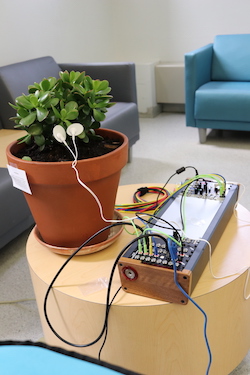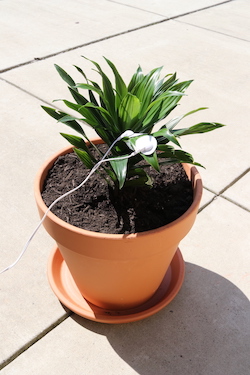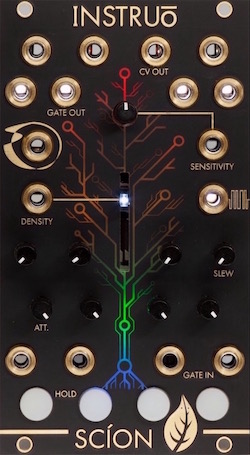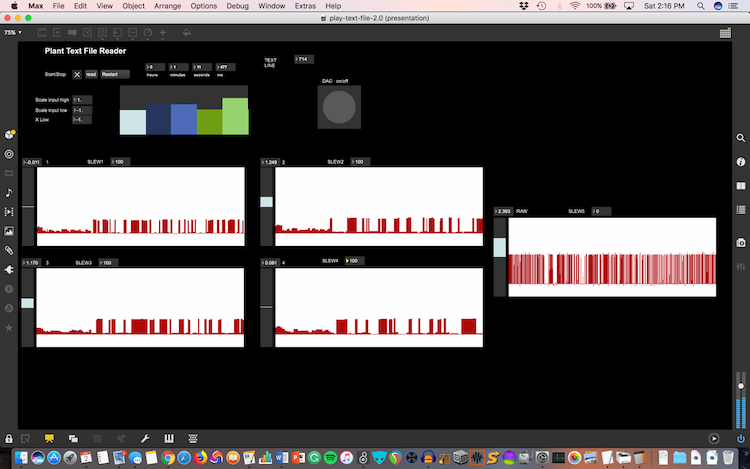Can a Leaf Make Music?Techniques and Aesthetics of Plant-Generated Control Voltage in Electronic MusicPoster presentation for the 2019 SMT National Conference in Columbus, OhioAnd many new developments! Dr. Paul Miller (Duquesne University), Brian Riordan (University of Pittsburgh) and Christopher Cox (Duquesne University) United States Botanical Garden -- June 2024 Download our Poster Test Subjects and Techniques Bibliography Annotated Discography Additional Links Max for Live System Metanoic Echos -- new for 2022 Biographies of Presenters -- from 2019 SMT presentation Some sound and video demonstrations -- Christopher Cox, May 2021 June 2024 I made two videos for this online presentation. Thanks so much to the USBG for inviting us! Video 1 -- Hardware and Software Techniques Video 2 -- Can a Plant Make Music? Ethical and Philosophical Questions The first stage was to collect data about how a plant responds to certain stimuli. To do this, Brian Riordan created a Max/MSP patch that recorded a great deal of data from Instruo's Scion Eurorack module. This, along with our bank of Expert Sleepers ES-8 and ES-6 interface modules, worked well for us, but it was expensive. We have since refined our work... 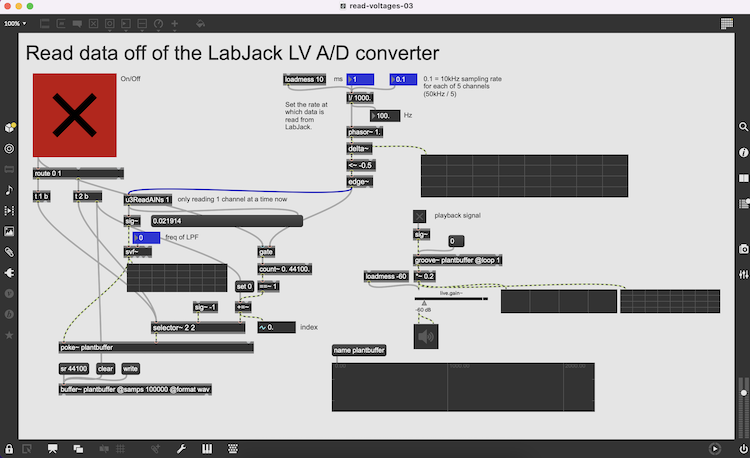
Affifi, Ramsey. "Learning Plants: Semiosis between the parts and the whole", Biosemiotics 6/3 (2013), pp. 547-59. [archived] Alpi et al., “Plant Neurobiology: No Brain, No Gain?” Trends in Plant Science, vol. 12/4 (2007), pp. 135-36. [online] l'Anson, Mileece. "Form, Chaos and the Nuance of Beauty", in The Oxford Handbook of Algorithmic Music, Roger T. Dean and Alex McLean, eds. New York: Oxford University Press, 2018, pp. 499-502. [archived] Body Mélanie J. A., Neer William C., Vore Caitlin, Lin Chung-Ho, Vu Danh C., Schultz Jack C., Cocroft Reginald B., Appel Heidi M. "Caterpillar Chewing Vibrations Cause Changes in Plant Hormones and Volatile Emissions in Arabidopsis thaliana". In Frontiers in Plant Science, 2019; 10: 810. [online]. Aristotle. On Plants. Loeb Classical Library, Harvard University Press, 2019. [online] Baluska, Frantisek and Stefano Mancuso, ed. Signaling in plants. Berlin: Springer Verlag, 2009. Beloff, Laura. "The Hearing Test: Evidence of a Vegetal Entity", Leonardo Music Journal 30 (2020), pp. 85-89. [archived] Besky, Sarah and Jonathan Padwe. "Placing Plants in Territory", Environment and Society 7 (2016), pp. 9-28. [archived] Beverly, David P. et. al., “Hydraulic and photosynthetic responses of big sagebrush to the 2017 total solar eclipse”, Scientific Reports 9 (2019) [online] Brenner, E.D. et al., “Plant Neurobiology: the Gain is More Than the Name”, Trends in Plant Science, vol. 12/7 (2007), pp. 285-6. [online] Burdon-Sanderson, J. "Note on the electrical phenomena which accompany irritation of the leaf of Dionaea muscipula." Proceedings of the Royal Society of London, vol. 21 (1873), pp. 495-6. [online] Canales, Javier and Carlos Henriquez-Valencia, Sebastian Brauchi. "The Integration of Electrical Signals Originating in the Root of Vascular Plants", Frontiers in Plant Science, 10 January 2018. [online] Chamovitz, Daniel. What a Plant Knows: A Field Guide to the Senses. New York: Scientific American (Farrar, Straus and Giroux,) 2012. Darwin, Charles. The Power of Movement in Plants. New York: D. Appleton and Company, 1898. [online] Demers, Joanna. Listening Through the Noise: The Aesthetics of Experimental Electronic Music. New York: Oxford University Press, 2010. Dunn, Peter and Loraine Leeson, “The Aesthetics of Collaboration”, Art Journal, vol. 56/1 (Spring 1997), pp. 26-37. [online] Fromm, Jörg and Silke Lautner. “Electrical Signals and their Physiological Significance in Plants,” Plant, Cell and Environment, vol. 30 (2006), pp. 249-57. [online] [archived] Fujieda, Mamoru. "Tuning of 'Patterns of Plants'", in Arcana IV: Musicians on Music, ed. John Zorn (Hips Road, 2009), pp. 140-150 [archived] Galston, Arthur W. and Clifford L. Slayman, “The Not-So-Secret Life of Plants: In which the historical and experimental myths about emotional communication between animal and vegetable are put to rest”, American Scientist, vol. 67/3 (May-June 1979), pp. 337-44. [online] Grond, Florian and Thomas Hermann, "Aesthetic Strategies in Sonification", AI and Society 12/2 (2012), 213-222. [archived] Holmes, Thom. Electronic and Experimental Music: Technology, Music and Culture. Philadelphia: Taylor and Francis, 2008. Jevbratt, Lisa. "Inquiries in Infomics", in "Network Art: Practices and Positions", ed. Tom Corby. Routledge (2006). [archived] Johns, Sarah et al. "The fast and the furious: rapid long-range signaling in plants," Plant Physiology 185 (2021), pp. 694-706. [archived] Jung, Jihye, Seon-Khu Kim, Joo Y. Kim, Mi-Jeong Jeong and Choong-Min Ryu. "Beyond Chemical Triggers: Evidence for Sound-Evoked Physiological Ractions in Plants", Frontiers in Plant Science 9:25 (30 January 2018) [archived] Khait, I. et al., "Plants emit informative airborne sounds under stress", unpublished MS. [archived] Krampen, Martin. "Phytosemiotics", Semiotica 36:3-4 (1981), pp. 187-209. [archived] Lee, Min-sun, Juyoung Lee, Bum-Jin Park, and Yoshifumi Miyazaki, "Interaction with indoor plants may reduce psychological and physiological stress by suppressing autonomic nervous system activity in young adults: a randomized crossover study", in Journal of Physiological Anthropology 35:21 (2015). [archived] Macedo, Francynês da Conceiçao Oliveira et al., "Equipment and protocol for measurement of extracellular electrical signals, gas exchange and turgor pressure in plants", MethodsX 8 (2021) [archived] Ooijen, Erik van. "Making mythopoeic meaning out of plants", Cogent Arts & Humanities 6/1 (2019). [archived] Perovich, Laura J. "Environmental art: A path to civic progress in a time of policy retreat in the United States", Cogent Arts & Humanities 5/1 (2018). [archived] Pollan, Michael, “Intelligent Plants”, The New Yorker, December 23 & 30, 2013. [online] and [archived]. Schultz, Jack C. “Shared Signals and the Potential for Phylogenetic Espionage Between Plants and Animals”, Integrated Comparative Biology. 42/3 (2002), pp. 454-62. [online] Sinclair, Peter, "Sonification: what where how why artistic practice relating sonification to environments", AI and Society 27 (2012), pp. 173-75. [archived] Stankovic, Bratislav, Daniel L. Witters, Tadeusz Zawadski and Eric Davies, "Action potentials and variation potentials in sunflower: An analysis of their relationships and distinguishing characteristics", Physiologia Plantarum 103 (1998), pp. 51-58. [archived] Till, Rupert, "Ambient Music and Religion", Bloomsbury Handbook for Religion and Popular Music, Christopher Partridge and Marcus Moberg (eds.), Bloomsbury: London, pp. 327-37. [archived] Tompkins, Peter and Christopher Bird. The Secret Life of Plants. New York: Harper & Row, 1973. Trewavas, Anthony, “Response to Alpi et al.: Plant neurobiology – all metaphors have value”, Trends in Plant Science vol. 12/6 (2007), pp. 231-3. [online] Tsadka, Maayan. "A Field Guide to Sonic Botany: Thoughts About Eco-Composition," Tempo, Vol 75 (295), January 2021, pp. 31-44. [online] (added 2/2021.) Uexküll, Thure von. "Introduction: Meaning and science in Jakob von Uexküll's concept of biology", Semiotica 42/1 (1982), pp. 1-24. [archived] War, Abdul Rashid et al., "Mechanisms of Plant Defense against Insect Herbivores", Plant Signaling and Behavior 7:10 (October 2012), pp. 1306-20. [archived] Xie, Jinjin, Yanyou We, Deke Xinbg, Zhongying Liu, Tian Chan, Rongrong Duan and Xiaoxing Zhu, "A comparative study on the circadian rhythm of the electrical signals of Broussonetia papyrifera and Morus alba", in Plant Signaling and Behavior 16:11 (2021) [archived] Ziegler, David. “How artist Sam Cusumano is creating music from apples and plants,” Technically Philly, 12 May 2014. [online] MidiSprout source code and design specifications: [online] Return to Top Mediation through compositional strategies: Mamoru Fujieda, Patterns of Plants, with Ishikawa, Maruta, Nishi, Noguchi, Ozawa, Teycheney, on Tzadik – TZ 7025, 1997, compact disc. Working with a “Plantron,” a device created by botanist and artist Yūji Dōgane, Japanese composer Mamoru Fujieda transcribed selected soundwaves from the micro-changes of surface-electric potential on plant leaves. The generated melodic material was then transposed and arranged for instruments in just intonation and Pythagorean tuning. Mamoru Fujieda, Patterns of Plants II, with Ishikawa, Maruta, Nishi, on Tzadik – TZ 8061, 2008, compact disc. Eleven years after the release of the original Patterns of Plants album, Fujieda released a new collection of transcriptions. Mamoru Fujieda, Patterns of Plants, with Cahill, on Pinna Records – PINNA 2, 2014, compact disc. This two-disc set is the first solo piano recording of Fujieda's music available outside of Japan. This new collection of transcriptions is performed in 12 tone equal temperament. Mediation through computer software: Miya Masaoka, Pieces for Plants [online] Pieces for Plants is an interactive installation for the American semi-tropical climbing philodendron, electrodes, and laptop. The work was also presented in the musical setting of an instrumental ensemble, where the plant acts as an active participant and soloist. Mileece, Formations, Lo Recordings – LCD30, 2002, compact disc. UK sound artist and environmental designer Mileece uses the SuperCollider programming language to create generative compositions by mediating data collected in real-time from plants. Mileece, Sacred Symbols of Mu, Planet Mu – ZIQ100CD, 2006, compact disc. Electronic music label Planet Mu presents their 100th release, Sacred Symbols of Mu, a compilation which features another plant oriented generative composition by Mileece entitled Tau. Mediation through MIDI: Data Garden, Quartet: Live at The Philadelphia Museum of Art, 2012. [online] Electronic impulses produced by four tropical plants are converted into MIDI and routed to different synthesizers, rhythmic tone generators, and effects. Duane Bridges, Plant Music: Volume 1 (Rushfoil I-VI and Dracanea I-VI), DMC 15, 2017. [online] St. Louis based composer Duane Bridges uses a MIDI sprout device to convert responses from plants to MIDI, which is then electronically manipulated. Duane Bridges, Plant Music: Volume 2 (Four Plantasias for Plant and E-Bowed Electric), DMC 16, 2017. [online] Continuing with his explorations of human-plant interaction, Duane Bridges creates four duets for plant and e-bowed electric guitar. Duane Bridges, Plant Music: Volume 3 (Garden Music), DMC 20, 2018. [online] The third volume of Duane Bridges Plant Music Series is a live recording in the gardens of the Humphrey Estate in Springfield, Illinois. Bridges claims to have set up a laptop that allows eight plants to respond, track by track, to the sounds they produce as well as the sounds of their botanical neighbors. Use of Raw output as audio signal: Helen Hé, Plants (Cranberries) for Electric Houseplants track 2 on HTAM S3E01, with How Things Are Made, 2017. [online] Oberlin Conservatory based composer Helen Hé made this composition for several of her custom-built sensors using modified Theremin kits. The raw data is then converted into audible waveforms. Mediation through Control Voltage: Kev Durr, Biofeedback Music #1: Abmient Eurorack Music feat. [online] Durr uses the same Scion interface module that we conducted our tests on. This is a brief but interesting video that sets down a shimmering timbral landscape. Gavin Fox, Plant, Interrupted 1.1 ~ Ambient Eurorack with the Instruo Scion. [online] Paul Miller, Carrot Music, [online] Miller's first serious plambient experiment making music with a carrot. Paul Miller and Devon Tipp, Jade Landscape, Shakuhachi and electronics. [online] Miller collaborated with Tipp, a Shakuhachi expert. For the first part of this performance, the plant didn't generate any significant voltage changes at all. Then it came alive and became so active that the challenge was trying to figure out how to bring the patch under control. Return to Top Plantwave at SXSW 2023 -- a very high-production event -- featuring a medatition practitioner, sound healer, etc. -- https://www.youtube.com/watch?v=_5udZRp-KYs Electricity for Progress -- Sam Cusumano's site. This is kind of the "mothership" for this kind of thing: [link] The AI and Society journal (Springer) devoted to the question of data sonification: vol. 27/2 The 1981 patent for TENS electrodes by Franklin C. Larimore (1981) -- [archived] The Institute for Plant Neurobiology: http://www.linv.org Pip's Plant Parlour -- an installation at the Tate Modern in 2019 -- [link] Symbiosa: an installation by Thiks Bierstecker and Stephan Mancuso: Mileece Abson's web page: [link] An article by Naomi Larsson in The Guardian from 13 May 2022: "Button Pushers: The Artists Making Music from Mushrooms" [archived] A very interesting forum discusson on ModWiggler: Biometric feedback discussion on ModWiggler Edwin Lucchesi's work:
Steve Sciulli's work: Damanhur Bamboo M and Plantwave devices:
And: https://www.media.mit.edu/projects/elowan-a-plant-robot-hybrid/overview/ Student project at Leeds Beckett University:
The extensive Springer series:
Augustine Leudar's work:
See also "Masterplants Orchestra" Return to Top In 2021, Christopher Cox brainstormed and built a new, inexpensive and high-quality interface. The first generation is on the left, and the second generation is on the right. Cox used his 3D printer to construct the black box for the second generation interface, which can simultaneously acquire the signals of five plants. 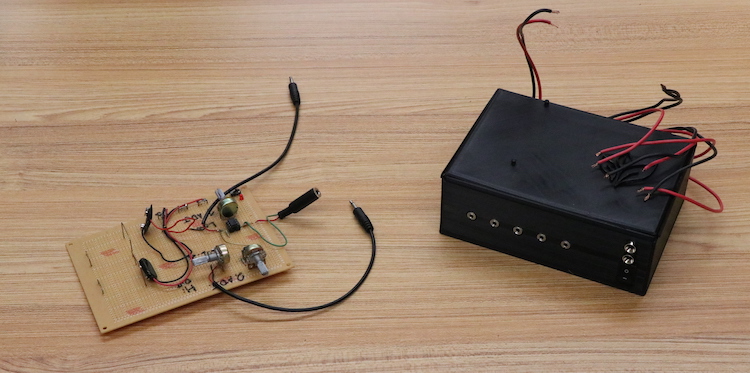
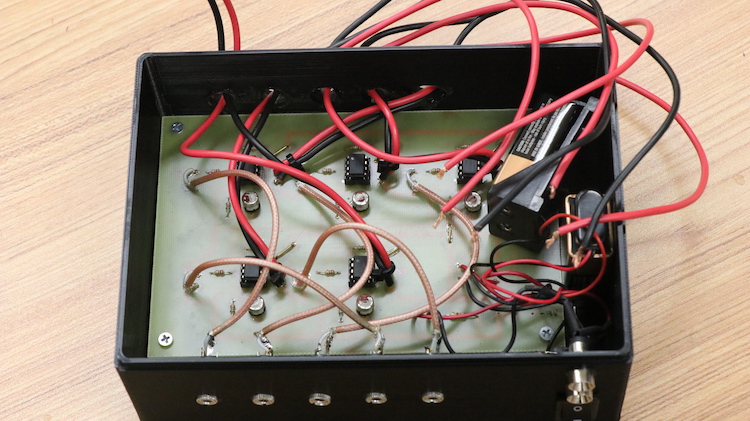
Paul Miller coded a patch in Max for Live to receive, scale and interpret the signals generated by Cox's interface. A subsequent version of the software was developed for the standalone version of Max/MSP. We are now working on a third-generation interface for an April 2022 installation at Duquesne's Gumberg Library. Here are some screen shots from May 2021. In this image the detector (which goes on an audio track) is only receiving random noise. 
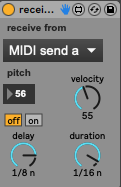

Return to Top Christopher Cox, Duquesne University URSS Symposium May 2021
Return to Top In spring 2022, we received a Paluse Grant from Duquesne University to build Metanoic Echos, an interspecies, interactive multimedia eco-installation. You can go visit its dedicated web site and enjoy many photos, videos and reactions from visitors! Return to Top Paul Miller is an Assistant Professor of Musicianship at Duquesne University’s Mary Pappert School of Music. He completed his Ph.D. in music theory at the Eastman School of Music in 2009, and earned a Master’s in viola performance there in 2006. Paul’s work has been published in Perspectives of New Music, Twentieth Century Music, Music and Letters, Opera Quarterly, and Early Music. He studied with Karlheinz Stockhausen for six summers in Germany, and performed extensively at the Darmstadt Festival from 2004-2010. A specialist in baroque music, he has held principal positions in the Washington Bach Consort and Opera Lafayette. Paul has served on the faculties of Temple University and CU-Boulder. He held a prestegious Mellon postdoctoral fellowship at Cornell for two years. Christopher Cox is a current sophomore at the Duquesne University Mary Pappert School of Music and is pursuing a B.M. in trumpet performance and studies under Chad Winkler of the Pittsburgh Symphony Orchestra. As a performer, Christopher has played as a soloist with the Westmoreland Symphony Orchestra in 2019 and gave the world premiere of Joseph Wilcox-Jenkins' Soupçon pour Sam for trumpet and piano alongside Dr. Ann Labounsky in 2021. He also plays with the Duquesne Symphony and Chamber orchestras, the Pittsburgh Youth Symphony Orchestra, and occasionally as an organist at the Duquesne University Chapel of the Holy Spirit. Alongside music, Christopher is an electronics hobbyist and enjoys designing, creating, and restoring devices from vacuum tube electronics to modern high end circuitry. Brian Riordan is a composer, performer, improviser, producer, and sound artist originally from Chicago, IL. He is an Andrew W. Mellon Fellow and a Ph.D. candidate in Music Composition and Theory at University of Pittsburgh. His research interests are in temporal discontinuity, delay-based performance, real-time digital signal processing, and laptop performance aesthetics. As an avid collaborator, he has performed in numerous ensembles ranging from rock, electronic, jazz, classical, and experimental. His compositions have been heard throughout North American, Europe, and Asia. Return to Top Copyright © 2019-2022 Paul V. Miller, Christopher Cox and Brian Riordan | ||||||
